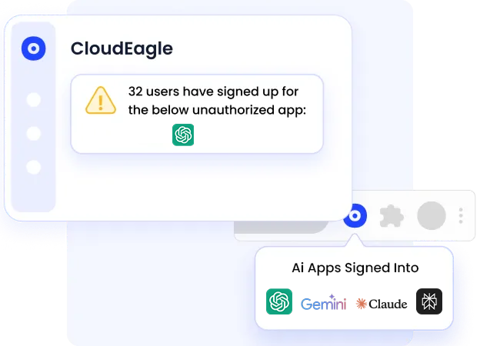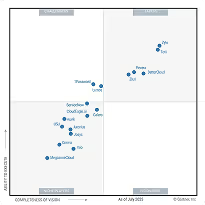HIPAA Compliance Checklist for 2025

AI tools like ChatGPT, Grammarly, and Notion AI are becoming common in the workplace. Employees often start using them to get work done faster, writing emails, analyzing data, or automating tasks.
A recent survey found nearly half of all knowledge workers use personal AI tools during work, driven by the lack of employer-approved options or the desire for more flexible solutions.
But in most cases, employees use AI tools without involving IT or procurement. These AI tools quietly slip into the system; this is known as shadow AI. It causes problems like poor visibility, weaker control over data, and the risk of exposing sensitive information.
In industries like healthcare, finance, or legal, using unapproved AI tools can break rules and lead to legal trouble. It’s not just a security risk; teams may buy the same tools twice, leave some unused, and increase software costs.
Let’s see why shadow AI is hard to catch, what problems it causes, and how to spot and control it before it hurts your business.
TL;DR
- AI tools are becoming common at work, but many employees use them without telling IT. These hidden tools, known as Shadow AI, are often free or bought with personal cards, making them hard to track.
- Using unapproved AI tools can be risky. Employees might share sensitive data like customer information or company files, leading to data leaks or privacy issues.
- Most companies can’t see these tools because they’re installed as browser extensions or accessed through work emails without IT’s approval.
- To fix this, companies should set clear AI rules, check what apps are being used, and watch browser activity or spending data. A tool like CloudEagle.ai makes this easier.
- CloudEagle.ai gives full visibility into all AI and SaaS tools, helps spot unapproved ones, and ensures everything used follows company policies and keeps data safe.
What are Unauthorized AI Tools?
Harmonic Security recently found that over 5,000 AI apps, including custom ChatGPT tools and AI-powered SaaS apps, had entered workplaces unnoticed, highlighting the rise of shadow AI.
Unauthorized AI tools are applications or services that employees use at work without formal approval from IT, security, or procurement teams. These tools are not listed in the company’s approved software stack and often operate under the radar, making them part of what’s known as shadow IT.
These tools may include:
- AI writing assistants like ChatGPT, Jasper, and Copy.ai.
- AI design tools like Canva AI, RunwayML, and Adobe Firefly.
- Browser extensions that automate workflows or summarize content.
- Data analysis tools using machine learning or predictive models
These tools can access and store company data, often in third-party environments with unclear data governance.
Employees usually turn to these tools to:
- Save time (e.g., AI email writing or data summarization),
- Solve problems quickly without waiting for formal procurement.
Most of the time, the intention isn’t harmful; they just want to get work done faster. But without oversight, these tools introduce significant risks.
Challenges of Using Unauthorized AI Tools or Shadow AI
As AI becomes more popular, employees often start using artificial intelligence tools like ChatGPT or browser extensions without telling the IT, procurement, or security teams. These hidden tools might seem helpful, but they can cause serious problems if left unchecked.
Data Privacy and Security Risks: Employees might enter sensitive data, like customer info or internal reports, into unapproved AI tools. This creates security risks, as companies can’t control where that data goes or how it’s used. It could get leaked or misused without anyone knowing.
Compliance Violations: SaaS companies must follow rules like GDPR, HIPAA, or SOC 2. If hidden tools process data without proper controls, the company could fail audits or face fines. Plus, they won’t have the full records needed to prove compliance.
Shadow IT and SaaS Sprawl: AI tools are easy to sign up for, so employees often use them without IT’s approval. Over time, this leads to too many tools being used(SaaS sprawl) without oversight, making it harder to manage security and spending.
Wasted Budget: If different teams use different artificial intelligence tools for similar tasks, costs go up. Companies miss out on bulk pricing, and unused tools may keep auto-renewing without anyone noticing, leading to wasted money.
Lack of Control or Governance: Without clear rules, employees might use AI tools for important tasks like writing contracts or answering customers. This can cause mistakes, biased outputs, or messages that don’t match your brand.
Damage to Brand Reputation: If a hidden AI tool leads to a data breach or mistake, it can harm customer trust. For SaaS companies serving large clients, this can mean losing deals or damaging long-term relationships.
How CloudEagle.ai Helps in Detecting and Preventing Shadow AI?
As the best AI apps become increasingly accessible, employees often start using them without informing IT, leading to a rise in Shadow AI. These tools, whether free or paid through personal cards, can create serious risks around data privacy, compliance, and cost management.
CloudEagle.ai eliminates these blind spots by giving organizations complete visibility, control, and governance over their SaaS and AI tool stack.
Complete Shadow App Visibility
CloudEagle.ai provides deep visibility into all AI and SaaS tools in your organization, whether officially purchased or quietly adopted by teams without approval. Its AI-powered discovery engine continuously scans login activities, usage patterns, and API data to identify both active and dormant tools, even those outside the procurement process.

To ensure no app goes unnoticed, CloudEagle combines multiple detection methods:
- SSO Integrations: It tracks all applications authenticated through identity providers like Okta, Azure AD, and Google Workspace. If users access artificial intelligence tools with their corporate credentials, CloudEagle flags them automatically.
- Finance & Expense Integration: By connecting with financial tools like NetSuite, Expensify, and corporate credit cards, CloudEagle detects unauthorized purchases, reimbursements, or subscriptions to AI tools, surfacing hidden or shadow spend.
- Browser Extension Analysis: Many AI tools are installed as browser extensions, like writing assistants or meeting bots. CloudEagle monitors extensions across company devices to flag any AI-based tools that haven’t gone through security or IT review.
This complete visibility helps IT and procurement teams stay in control, reduce risk, and ensure all AI usage aligns with company policy and compliance standards.
Automated AI App Detection and Categorization
CloudEagle.ai goes beyond listing apps—it intelligently identifies which tools are AI-powered and categorizes them based on risk level, function, and usage.

Whether it’s generative AI platforms like ChatGPT and Jasper, meeting tools with built-in AI summarizers like Fireflies.ai, or AI-powered writing and coding assistants like GrammarlyGO or GitHub Copilot, CloudEagle gives you clarity on how AI is embedded across your SaaS stack. This helps teams understand the real impact of AI, even when it's part of tools they already use.
Eliminates Shadow AI Spend
CloudEagle provides real-time visibility into both approved and unapproved app purchases. It flags duplicate AI subscriptions across departments and identifies when freemium tools quietly switch to paid plans.
By consolidating tool usage, procurement teams can negotiate better pricing, reduce unnecessary spend, and avoid overlapping subscriptions, leading to smarter budgeting and cost savings.
Enforces Policy and Approval Workflows
To prevent unauthorized tool adoption, CloudEagle enables companies to set up automated approval workflows for every new software request. If an employee tries to use an unapproved AI tool, the platform can route the request through IT, security, and procurement.
Teams can compare features, benchmark pricing, and approve or deny requests—all while ensuring the tool meets internal compliance and security policies.
Centralized Dashboard for AI Tool Monitoring
CloudEagle provides a real-time, centralized dashboard that shows all AI and SaaS tools in use across the organization. Teams can view alerts for newly detected or unauthorized tools, monitor license usage trends, get renewal reminders, and track vendor-related risks.

This visibility simplifies AI governance and integrates seamlessly into your overall software asset management strategy.
Audit-Ready Compliance and Security Control
Hidden artificial intelligence tools can create serious compliance gaps under standards like SOC 2, GDPR, HIPAA, and ISO 27001. CloudEagle.ai makes IT compliance easier by automating access control, onboarding/offboarding, and audit reporting. Everything is managed from one dashboard, so you can stay secure and ready for audits without the stress.

How to Prevent Shadow AI From Recurring?
Preventing Shadow AI, unauthorized or unapproved AI tools, from creeping back into your SaaS environment requires a mix of visibility, governance, and employee awareness. Here's how SaaS companies can stay protected:
Implement SaaS App Discovery Tools: Use platforms like CloudEagle.ai to automatically detect all AI-powered apps being used, even if they weren’t IT-approved. This helps surface shadow tools before they become a problem.
Set Clear AI Usage Policies: Create and enforce policies around AI usage—what’s allowed, what needs approval, and what’s off-limits. Make it easy for teams to understand the risks and get the tools they need through approved channels.
Control Access With SSO and RBAC: Use Single Sign-On (SSO) and Role-Based Access Controls (RBAC) to ensure employees can only access artificial intelligence tools that are vetted and approved. This prevents unauthorized signups with work emails.
Conduct Regular Access Reviews: Review app access quarterly or monthly to identify any new tools, expired licenses, or suspicious access patterns. Flag any unknown AI apps immediately.
Educate Teams Continuously: Make AI governance part of your onboarding and training. Teach teams about responsible AI use, data security risks, and how to request new tools safely.
Monitor and Automate: Set up continuous monitoring with automated alerts for new app signups, browser extension installations, or AI usage outside your tool stack. Platforms like CloudEagle.ai can handle this at scale.
Conclusion
Shadow AI might not seem like a big issue at first—just a few team members using artificial intelligence tools to speed up their work. But without proper oversight, these tools can create serious problems for your company. From security risks and data leaks to compliance violations and unnecessary costs, hidden AI usage can silently damage your business, especially in fast-moving SaaS environments.
SaaS companies thrive on speed, trust, and innovation. That’s why it's important to take control before Shadow AI becomes a bigger problem. Start by gaining full visibility into the tools your teams are using, setting clear rules, and educating everyone about safe AI usage.
CloudEagle.ai can make this process simple. It helps you discover unauthorized tools, automate approvals, and ensure all AI and SaaS apps follow company policies.
Want to stay ahead of Shadow AI?
Book a demo with CloudEagle.ai today to get full control and peace of mind.
Frequently Asked Questions
1. What are the tools of AI?
AI tools include machine learning platforms, NLP tools, robotics, chatbots, and computer vision software.
2. What are the top 5 generative AI tools?
ChatGPT, DALL·E, Midjourney, Claude, and Bard are popular generative AI tools in 2025.
3. What are artificial intelligence tools?
These are software or platforms that simulate human intelligence tasks like learning, reasoning, or problem-solving.
4. What is the most used tool?
ChatGPT is currently one of the most widely used free AI chat tools globally, known for its versatility in answering questions, generating content, and supporting various business and personal use cases.
5. Where are AI tools used?
AI tools are used in healthcare, finance, marketing, education, cybersecurity, and customer support.
6. What are the best AI chat tools?
The best AI chat tools include ChatGPT, Google Gemini, Claude, Jasper Chat, and Microsoft Copilot. These tools help with tasks like answering questions, drafting content, summarizing data, and automating support—all powered by advanced AI.

%201.svg)










.avif)




.avif)
.avif)




.png)









